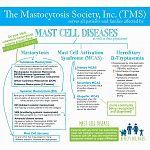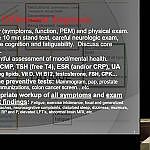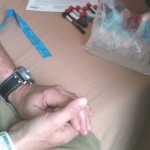(The first part of this blog is taken from an article called "Hacking the Nervous System" published by the Huffington Post)
Maria Vrind's superb level of fitness offered her no protection against the insidious immune process taking place in her body. By her late forties, this former gymnast had to give up her athletic coaching job. By her early fifties she was in severe pain, couldn’t walk and her knees, wrists, ankles, elbows and shoulder joints felt like they were on fire. She had a severe case of rheumatoid arthritis.
[fright]

[/fright]It took a cocktail of powerful drugs (including methotrexate - a chemotherapy agent) simply keep her functioning. One day - one moment, really - in 2011 the drugs mysteriously stopped working. Unable to walk and in terrible pain she was rushed to the hospital hospital where an IV dripped a chemotherapy agent into her veins.
The drug worked but she dreaded a life of disability and monthly chemotherapy treatments. As it turned out chemotherapy drugs were not n her future. A new treatment from an entirely different source offered her relief beyond her wildest dreams.
The Vagus Nerve
The genesis of that treatment began decades earlier when a young neurosurgeon, Kevin Tracey, injected an anti-inflammatory agent into a mouse brain. To his surprise it reduced inflammation in the mouse's internal organs.
Suspecting the vagus nerve - that long nerve stretching from the brain to organs - had something to do with it, Tracey cut the nerve and then supplied the anti-inflammatory agentt again. This time it had no effect. Then he ditched the anti-inflammatory and stimulated the nerve electrically and watched the inflammation in the body go down. The vagus nerve was the brains conduit to the immune system.
Chronic Fatigue Syndrome, Fibromyalgia and the Vagus Nerve
The yin to the sympathetic nervous system's (SNS) yang, the vagus nerve controls the "rest and digest" or parasympathetic nervous system (PNS). The default for human beings is to have the SNS or fight or flight system on all the time. If not for the vagus nerve stepping in and turning the SNS down we would continually be enveloped in a fight or flight response. Feelings of peace, calmness and relaxation would evaporate, digestion would suffer, our hearts would race and we'd be unable to sleep.
Heart rate variability studies suggest that an under-active vagus nerve is allowing the SNS to stay turned on much of the time in ME/CFS and FM. These studies suggest that the overactive "fight or flight" system may be contributing to the "wired and tired" feelings, and fatigue, pain, sleep and cognitive problems found in these diseases. It may even affect mood. According to the Huffington post article people with a high vagal tone tend to be socially and psychologically stronger, are better at concentrating and remembering things, suffer less from depression and are happier and more likely to have close friendships.
The Vagus Nerve and Inflammation
Tracey spent over a decade tracing anatomically how the vagus nerve effects the immune system in the body. By the time he was done he was ready to test his hypothesis by surgically implanting a vagus nerve stimulator in patients high rates of inflammation.
Marina Vrinds was one of the first to try. The researchers and participants hoped for some relief. What they got astonished them. Within a few weeks Marina went from her chemotherapy dependent disabled state to being not just functional but active. Shortly after turning the stimulator on she was back riding her bicycle and participating in gymnastic for the first time in years.
Now 68 Vrind is a very active senior. She plays and teaches seniors volleyball several times a week, cycles at least an hour a day, does gymnastics, and plays with her eight grandchildren. All this from turning on a stimulator six times a day for thirty seconds using a magnet she waves across her throat.
Not everybody in the trial experienced such miraculous recoveries but the stimulation essentially wiped out the RA in a solid third of the participants of the trial. The levels of inflammatory markers went down in 80% of the patients.
Neither ME/CFS or FM patients typically display anywhere near the kind of inflammatory levels occurring in rheumatoid arthritis patients. Our understanding of inflammation is, however, changing. Inflammatory disorders need not necessarily display the swollen, reddened joints found in RA. Much of the inflammation found may be hidden in the central nervous system or is simply not being detected by current testing protocols.
A recent blog recounted a remarkable story of a woman's recovery from severe fibromyalgia using a surgically implanted vagus nerve stimulator. Now, let's take a deeper look at the critical role the vagus nerve plays in immune functioning.
The Vagus Nerve and the Immune System
[fright]

[/fright]The vagus nerve is primarily composed of sensory nerve fibers that transmit sensory information to the brain. That flow of sensory information provides much more than data on things like temperature, touch and pain. Recent studies indicate the nerve is loaded with immune receptors that also transmit data on inflammation and the presence of pathogens to the brain. In fact, the vast network of vagal nerve endings found in the skin and other mucosal areas is suggested to provide an early warning network that can quickly transmit news of a pathogen attack to the brain.
Immune signals down the vagus nerve from the brain can initiate what has been termed an "inflammatory reflex" that is designed to tamp down inflammation. Since the vagus nerve does not reach into the spleen how that happened was a mystery.
Solving that mystery opened up a new form of immune regulation called the cholinergic anti-inflammatory pathway.
The Cholinergic Anti-inflammatory Pathway
Signals traveling down the vagus nerve cause nerves in the spleen to release norepinephrine. The NE triggers T-cells to release acetylcholinesterase (Ach), which then turns off the production of pro-inflammatory cytokines such as TNF-a.
The spleen is not the only area that vagus nerve modulation may effect. Animal models suggest vagal nerve stimulation of the cholinergic anti-inflammatory pathway may be helpful in a variety of inflammatory conditions including colitis, autoimmune and cardiovascular disorders and pain disorders including allodynia.
The anti-inflammatory actions of the vagus nerve and how it achieves them are complex and not completely understood and some controversy exists.
Mostly Anecdotal
Vagus nerve stimulation has produced wonders in some patients with fibromyalgia and rheumatoid arthritis, but the evidence base in humans is still weak and animal studies are common. A recent VNS study in mood disorders, for instance, consisted of five patients (three with positive outcomes.)
Vagus nerve stimulation trials currently underway using trancutaneous vagal nerve stimulation (no surgery needed) include those on gut motility, irritable bowel syndrome, cluster headaches). Surgically implanted devices are being tested in epilepsy, Crohn's disease, tinnitus, stroke and heart failure. A transcutaneous VNS study in migraine wrapped up a year or so ago. Note that migraine, problems with gut motility and irritable bowel syndrome are common in ME/CFS and FM.
VNS is a new and developing field. Heart rate variability studies reveal that low "vagal' tone is common in many disorders including arthritis, depression, heart failure, diabetes, asthma, headache, fibromyalgia,ME/CFS and others. Many of these disorders, it should be noted, have an inflammatory component. It should be noted as well that studies have consistently associated low vagal tone with increased risk of mortality. Reduced vagal functioning appears to either set one up for a chronic illness (low vagal tone is a risk factor for diabetes) that reduces ones lifespan or is a common component of chronic illness.
Finding ways to boost vagal nerve activity and reduce inflammation through drugs (nAChRα7 enhancers), vagal nerve stimulation or mind/body techniques (meditation, mindfulness) will surely continue.
Dig Deeper:
Maria Vrind's superb level of fitness offered her no protection against the insidious immune process taking place in her body. By her late forties, this former gymnast had to give up her athletic coaching job. By her early fifties she was in severe pain, couldn’t walk and her knees, wrists, ankles, elbows and shoulder joints felt like they were on fire. She had a severe case of rheumatoid arthritis.
[fright]
[/fright]It took a cocktail of powerful drugs (including methotrexate - a chemotherapy agent) simply keep her functioning. One day - one moment, really - in 2011 the drugs mysteriously stopped working. Unable to walk and in terrible pain she was rushed to the hospital hospital where an IV dripped a chemotherapy agent into her veins.
The drug worked but she dreaded a life of disability and monthly chemotherapy treatments. As it turned out chemotherapy drugs were not n her future. A new treatment from an entirely different source offered her relief beyond her wildest dreams.
The Vagus Nerve
The genesis of that treatment began decades earlier when a young neurosurgeon, Kevin Tracey, injected an anti-inflammatory agent into a mouse brain. To his surprise it reduced inflammation in the mouse's internal organs.
Suspecting the vagus nerve - that long nerve stretching from the brain to organs - had something to do with it, Tracey cut the nerve and then supplied the anti-inflammatory agentt again. This time it had no effect. Then he ditched the anti-inflammatory and stimulated the nerve electrically and watched the inflammation in the body go down. The vagus nerve was the brains conduit to the immune system.
Chronic Fatigue Syndrome, Fibromyalgia and the Vagus Nerve
The yin to the sympathetic nervous system's (SNS) yang, the vagus nerve controls the "rest and digest" or parasympathetic nervous system (PNS). The default for human beings is to have the SNS or fight or flight system on all the time. If not for the vagus nerve stepping in and turning the SNS down we would continually be enveloped in a fight or flight response. Feelings of peace, calmness and relaxation would evaporate, digestion would suffer, our hearts would race and we'd be unable to sleep.
Heart rate variability studies suggest that an under-active vagus nerve is allowing the SNS to stay turned on much of the time in ME/CFS and FM. These studies suggest that the overactive "fight or flight" system may be contributing to the "wired and tired" feelings, and fatigue, pain, sleep and cognitive problems found in these diseases. It may even affect mood. According to the Huffington post article people with a high vagal tone tend to be socially and psychologically stronger, are better at concentrating and remembering things, suffer less from depression and are happier and more likely to have close friendships.
The Vagus Nerve and Inflammation
Tracey spent over a decade tracing anatomically how the vagus nerve effects the immune system in the body. By the time he was done he was ready to test his hypothesis by surgically implanting a vagus nerve stimulator in patients high rates of inflammation.
Marina Vrinds was one of the first to try. The researchers and participants hoped for some relief. What they got astonished them. Within a few weeks Marina went from her chemotherapy dependent disabled state to being not just functional but active. Shortly after turning the stimulator on she was back riding her bicycle and participating in gymnastic for the first time in years.
Now 68 Vrind is a very active senior. She plays and teaches seniors volleyball several times a week, cycles at least an hour a day, does gymnastics, and plays with her eight grandchildren. All this from turning on a stimulator six times a day for thirty seconds using a magnet she waves across her throat.
Not everybody in the trial experienced such miraculous recoveries but the stimulation essentially wiped out the RA in a solid third of the participants of the trial. The levels of inflammatory markers went down in 80% of the patients.
Neither ME/CFS or FM patients typically display anywhere near the kind of inflammatory levels occurring in rheumatoid arthritis patients. Our understanding of inflammation is, however, changing. Inflammatory disorders need not necessarily display the swollen, reddened joints found in RA. Much of the inflammation found may be hidden in the central nervous system or is simply not being detected by current testing protocols.
A recent blog recounted a remarkable story of a woman's recovery from severe fibromyalgia using a surgically implanted vagus nerve stimulator. Now, let's take a deeper look at the critical role the vagus nerve plays in immune functioning.
The Vagus Nerve and the Immune System
[fright]
[/fright]The vagus nerve is primarily composed of sensory nerve fibers that transmit sensory information to the brain. That flow of sensory information provides much more than data on things like temperature, touch and pain. Recent studies indicate the nerve is loaded with immune receptors that also transmit data on inflammation and the presence of pathogens to the brain. In fact, the vast network of vagal nerve endings found in the skin and other mucosal areas is suggested to provide an early warning network that can quickly transmit news of a pathogen attack to the brain.
Immune signals down the vagus nerve from the brain can initiate what has been termed an "inflammatory reflex" that is designed to tamp down inflammation. Since the vagus nerve does not reach into the spleen how that happened was a mystery.
Solving that mystery opened up a new form of immune regulation called the cholinergic anti-inflammatory pathway.
The Cholinergic Anti-inflammatory Pathway
Signals traveling down the vagus nerve cause nerves in the spleen to release norepinephrine. The NE triggers T-cells to release acetylcholinesterase (Ach), which then turns off the production of pro-inflammatory cytokines such as TNF-a.
The spleen is not the only area that vagus nerve modulation may effect. Animal models suggest vagal nerve stimulation of the cholinergic anti-inflammatory pathway may be helpful in a variety of inflammatory conditions including colitis, autoimmune and cardiovascular disorders and pain disorders including allodynia.
The anti-inflammatory actions of the vagus nerve and how it achieves them are complex and not completely understood and some controversy exists.
Mostly Anecdotal
Vagus nerve stimulation has produced wonders in some patients with fibromyalgia and rheumatoid arthritis, but the evidence base in humans is still weak and animal studies are common. A recent VNS study in mood disorders, for instance, consisted of five patients (three with positive outcomes.)
Vagus nerve stimulation trials currently underway using trancutaneous vagal nerve stimulation (no surgery needed) include those on gut motility, irritable bowel syndrome, cluster headaches). Surgically implanted devices are being tested in epilepsy, Crohn's disease, tinnitus, stroke and heart failure. A transcutaneous VNS study in migraine wrapped up a year or so ago. Note that migraine, problems with gut motility and irritable bowel syndrome are common in ME/CFS and FM.
VNS is a new and developing field. Heart rate variability studies reveal that low "vagal' tone is common in many disorders including arthritis, depression, heart failure, diabetes, asthma, headache, fibromyalgia,ME/CFS and others. Many of these disorders, it should be noted, have an inflammatory component. It should be noted as well that studies have consistently associated low vagal tone with increased risk of mortality. Reduced vagal functioning appears to either set one up for a chronic illness (low vagal tone is a risk factor for diabetes) that reduces ones lifespan or is a common component of chronic illness.
Finding ways to boost vagal nerve activity and reduce inflammation through drugs (nAChRα7 enhancers), vagal nerve stimulation or mind/body techniques (meditation, mindfulness) will surely continue.
Dig Deeper:
Attachments
Last edited:

















